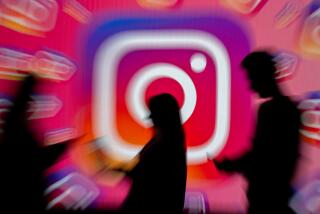BOOK REVIEW / NONFICTION : Logging On to a New World : BEING DIGITAL <i> by Nicholas Negroponte</i> ; Knopf $23, 231 pages
- Share via
For those of us cowed by the Computer Age, there is some comfort to be had in the fact that even Nicholas Negroponte, director of the sky-high-tech Media Lab at the Massachusetts Institute of Technology, often feels flustered too.
“There’s obviously no speed limit on the electronic highway,” he grumbles here. “It’s like driving on the autobahn at 160 k.p.h. Just as I realize the speed I’m going, zzzwoom , a Mercedes passes, then another, then another.”
Still, at least Negroponte is trying to zwoom, and as he successfully if immodestly explains, this is no mean feat. For “being digital” involves more than buying the latest silicon gadgets. It means learning to envision the world in terms of bits (“the smallest . . . element in the DNA of information”) instead of atoms.
It’s a radically new world view, one that dissolves the distinctions we’ve held dear between producers and consumers (soon you’ll be able to sign on and edit your local paper or play your favorite movie character); between telephones, TV sets and computers (soon they’ll be incorporated into one device)--even between different continents.
Pointing out that most jobs now being created involve producing “digital” goods, like architectural drafts and multimedia games rather than “atomic” goods like cars, Negroponte predicts that future factories will be able to operate around the clock by shuttling projects around the world.
When London workers sign off their PCs, Seattle workers will sign on, picking up where the English left off. And when the Northwesterners go home, they’ll hand the ball to Tokyo.
Like many futurists, Negroponte takes devilish pleasure in tweaking American business for the stodgy way in which it applies old thinking to new technology.
For example, he shows how high-definition-TV broadcasters have focused on insipid applications such as showing “Seinfeld” at twice today’s resolution rather than on inspired ones such as enabling viewers to watch a baseball game from any seat in the stadium, “or, for that matter, from the perspective of the baseball.”
Also like many futurists, however, Negroponte sometimes lets his romanticism eclipse his reason. While his vintage-futurist rhetoric suggests that a big, beautiful era of freedom lies just around the corner, his examples suggest that freedom will prove more elusive.
For instance, he waxes enthusiastic about the virtue of “open” computer operating systems--wherein we can “compete with our imagination, not with a lock and key”--but he fails to show how copyright can be protected in such systems.
Negroponte also overestimates the degree to which consumers will want to use computers to stretch their minds.
Negroponte himself loves brain teasers. In a hilarious aside, he recalls a scavenger hunt he took while a boarding-school student in Switzerland.
Roaming the country for five days, he showed up in the middle of the night at one particular latitude and longitude to retrieve a message written in Urdu and dropped from a helicopter.
The missive instructed him to find a live pig and bring it to a certain location, which he did, thus winning the game.
The question remains, though: Will most consumers want to work out similarly daunting challenges on their home computers? Negroponte thinks so, pointing out that in our interactive future, “reading a book by William F. Buckley Jr. will be like having a conversation with him.”
But will tomorrow’s readers really want to take on that dauntless debater or double click on their mice to compose alternate conclusions to “Macbeth”?
Or will they prefer to let Buckley and Shakespeare order their “data” for them?
Negroponte, in short, is able to tell us more about the capabilities of our technology than about the proclivities of our culture.
Still, he is blessed with an unusually artistic background for a techie--in school he studied architecture and graphic design.
It pays off in simple but brilliant insights, such as his realization that fax machines represent not the new frontier but rather “a step backward.”
Requiring us to convert digitized information into paper printouts by “squeezing ink onto dead trees,” then to re-digitize that information for transmission, and then to reprint it back on trees, faxes are, he explains, wildly inefficient when compared to e-mail.
They caught on in America not because of their intrinsic economic logic, but because they were invented by the Japanese, whose pictographic Kanji language is currently best represented on paper.
Roman-letterer Negroponte, in contrast, is clearly no fan of reading from “cancerous-feeling, slimy paper, sometimes uncut and reminiscent of ancient scrolls.”
“Give me a break,” he squawks. “This is about as sensible as sending each other tea leaves.”
More to Read
Sign up for our Book Club newsletter
Get the latest news, events and more from the Los Angeles Times Book Club, and help us get L.A. reading and talking.
You may occasionally receive promotional content from the Los Angeles Times.










